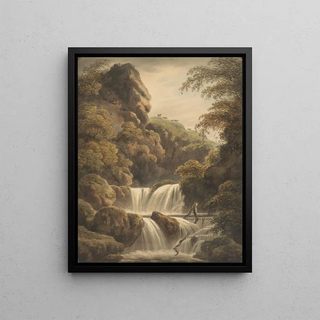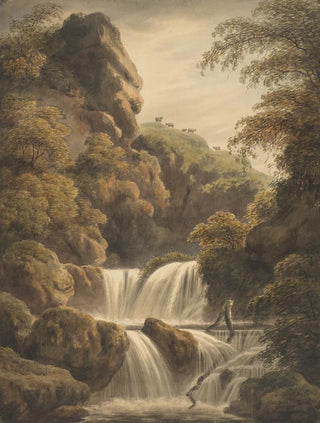Art print | In Linton North Devon - John William Upham


View from behind

Frame (optional)
In the vast panorama of 19th-century British art, the artwork "À Linton North Devon" by John William Upham stands out for its ability to capture the very essence of nature. This painting, imbued with poetry and light, invites the viewer to immerse themselves in a pastoral landscape where tranquility reigns supreme. Contemplating this piece, one feels a deep connection with the land, as if each brushstroke reveals an ancient secret whispered by the wind through the trees. The art print of "À Linton North Devon" by John William Upham allows for rediscovering this masterpiece, a symbol of an era when art and nature harmoniously intertwined.
Style and uniqueness of the work
John William Upham's style is characterized by meticulous attention to detail and a subtle use of colors that convey natural light. In "À Linton North Devon," the various shades of green evoke the lushness of the meadows, while the skies, often radiant, seem to vibrate with invigorating energy. The artist manages to create a serene, almost meditative atmosphere, where every element of the landscape—from majestic trees to winding rivers—is rendered with precision that reflects his love for nature. This work is much more than a simple representation; it is an invitation to explore a world where time seems suspended, where one can almost hear the whisper of leaves and the song of birds.
The artist and his influence
John William Upham, though less known than some of his contemporaries, managed to leave his mark on his era through a unique approach to landscape painting. Raised in an environment where art and nature coexisted, he developed a style that reflects a deep admiration for British landscapes. His influence is evident not only in his works but also in how he inspired other artists to embrace the beauty of rural scenes. Upham captured the spirit of his time, an era when industrialization began transforming the British landscape, and his work remains a valuable testament to this transition. Through his canvases, he conveyed a nostalgia for a disappearing world—a world that many still seek.

Matte finish

View from behind

Frame (optional)
In the vast panorama of 19th-century British art, the artwork "À Linton North Devon" by John William Upham stands out for its ability to capture the very essence of nature. This painting, imbued with poetry and light, invites the viewer to immerse themselves in a pastoral landscape where tranquility reigns supreme. Contemplating this piece, one feels a deep connection with the land, as if each brushstroke reveals an ancient secret whispered by the wind through the trees. The art print of "À Linton North Devon" by John William Upham allows for rediscovering this masterpiece, a symbol of an era when art and nature harmoniously intertwined.
Style and uniqueness of the work
John William Upham's style is characterized by meticulous attention to detail and a subtle use of colors that convey natural light. In "À Linton North Devon," the various shades of green evoke the lushness of the meadows, while the skies, often radiant, seem to vibrate with invigorating energy. The artist manages to create a serene, almost meditative atmosphere, where every element of the landscape—from majestic trees to winding rivers—is rendered with precision that reflects his love for nature. This work is much more than a simple representation; it is an invitation to explore a world where time seems suspended, where one can almost hear the whisper of leaves and the song of birds.
The artist and his influence
John William Upham, though less known than some of his contemporaries, managed to leave his mark on his era through a unique approach to landscape painting. Raised in an environment where art and nature coexisted, he developed a style that reflects a deep admiration for British landscapes. His influence is evident not only in his works but also in how he inspired other artists to embrace the beauty of rural scenes. Upham captured the spirit of his time, an era when industrialization began transforming the British landscape, and his work remains a valuable testament to this transition. Through his canvases, he conveyed a nostalgia for a disappearing world—a world that many still seek.






